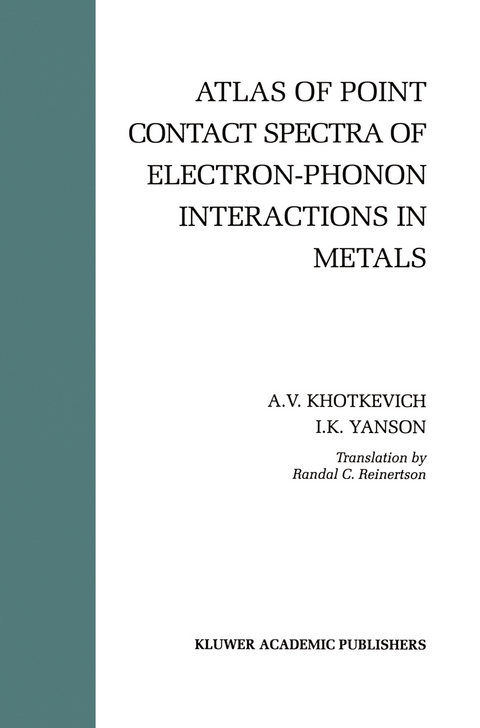
Atlas of Point Contact Spectra of Electron-Phonon Interactions in Metals
Springer-Verlag New York Inc.
978-1-4613-5955-5 (ISBN)
1. The Method of Point Contact Spectroscopy.- 1.1 Models of Point Contacts.- 1.2 Regimes of Electron Transport Through a Constriction.- 1.3 Resistance at Zero Bias.- 1.4 Nonequilibrium Electron Distribution Functions.- 1.5 Principal Theoretical Relationships.- 1.6 The Electron-phonon Interaction Point Contact Functions.- 1.7 Heterocontacts.- 1.8 Two-phonon Processes.- 1.9 Comparison of Electron-phonon Interaction Point Contact Functions to Related Functions.- 1.10 Background.- 1.11 Point Contact Spectroscopy of Non-phonon Excitations.- 1.12 Methods of Forming Point Contacts.- 1.13 Quality Criteria.- 1.14 Modulation Methods for Measuring Derivatives of the Current-voltage Characteristics.- 1.15 Modulation Broadening of Spectral Lines.- 1.16 Block Diagram of a Spectrometer.- 1.17 The Procedure for Reconstruction of the Electron-phonon Interaction Point Contact Function From Measured Characteristics.- 1.18 Pseudopotential Calculations of the Electron-phonon Interaction Point Contact Functions.- 1.19 Methods for Determining the Electron-phonon Interaction Functions and the Phonon Density of States.- 2. Point Contact Spectra, Electron-Phonon Interaction Functions, and The Phonon Density of States in Metals.- 2.1 Lithium.- 2.2 Sodium.- 2.3 Potassium.- 2.4 Copper.- 2.5 Silver.- 2.6 Gold.- 2.7 Beryllium.- 2.8 Magnesium.- 2.9 Zinc.- 2.10 Cadmium.- 2.11 Aluminum.- 2.12 Gallium.- 2.13 Indium.- 2.14 Thallium.- 2.15 Tin.- 2.16 Lead.- 2.17 Vanadium.- 2.18 Niobium.- 2.19 Tantalum.- 2.20 Molybdenum.- 2.21 Tungsten.- 2.22 Technetium.- 2.23 Rhenium.- 2.24 Iron.- 2.25 Cobalt.- 2.26 Nickel.- 2.27 Palladium.- 2.28 Osmium.- 2.29 Gadolinium.- 2.30 Terbium.- 2.31 Holmium.- Reference.
| Übersetzer | Randal C. Reinertson |
|---|---|
| Zusatzinfo | XIII, 151 p. |
| Verlagsort | New York, NY |
| Sprache | englisch |
| Maße | 155 x 235 mm |
| Themenwelt | Naturwissenschaften ► Physik / Astronomie ► Atom- / Kern- / Molekularphysik |
| Naturwissenschaften ► Physik / Astronomie ► Festkörperphysik | |
| Naturwissenschaften ► Physik / Astronomie ► Thermodynamik | |
| ISBN-10 | 1-4613-5955-4 / 1461359554 |
| ISBN-13 | 978-1-4613-5955-5 / 9781461359555 |
| Zustand | Neuware |
| Haben Sie eine Frage zum Produkt? |
aus dem Bereich


